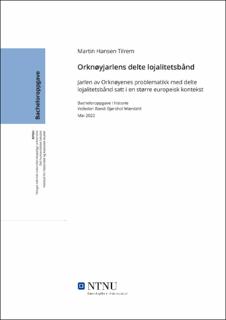| dc.contributor.advisor | Wærdahl, Randi Bjørshol | |
| dc.contributor.author | Tilrem, Martin | |
| dc.date.accessioned | 2022-06-14T17:19:41Z | |
| dc.date.available | 2022-06-14T17:19:41Z | |
| dc.date.issued | 2022 | |
| dc.identifier | no.ntnu:inspera:110289010:46775856 | |
| dc.identifier.uri | https://hdl.handle.net/11250/2998749 | |
| dc.description.abstract | Temaet for denne bacheloroppgaven er de delte lojalitetsbåndene hos jarlene på Orknøyene, satt i en større, europeisk kontekst. Jarlen av Orknøyene og Caithness hadde likestilte lojalitetsbånd til både den skotske og den norske kongen. Dette skapte problemer da de to kongemakter havnet i strid med hverandre i 1263. Magnus jarl Gilbertsson ble satt i enn tilnærmet umulig skvis mellom sine to overherrer. Problemstillingen er som følger:
Hvorfor ble det på 1200-tallet vanskeligere for jarlene på Orknøyene å opprettholde sine delte lojalitetsbånd til henholdsvis den norske og skotske kongemakten, og var utviklingen lik ellers i Europa?
Jeg besvarer problemstillingen i tre deler. Først forsøker jeg å etablere hvor alvorlig sviket til Magnus jarl Gilbertsson var i 1263. Så skildrer jeg utviklingen av kongerikene Norge og Skottland, og sammenligner denne utviklingen med maktkonsolideringen til kongemakter ellers i Nordvest-Europa. Til slutt sammenligner jeg situasjonen til Magnus jarl Gilbertsson med andre europeiske fyrster på 11- og 1200-tallet som hadde lignende problemstillinger. Jeg baserer drøftingen på kildene Håkon Håkonsson saga og Hirdskråen, samt tidligere forskning innenfor tema.
Mine undersøkelser viser at orknøyjarlens svik, til tross for begrensede konsekvenser, ble regnet som alvorlig også i sin samtid. Det var de europeiske kongerikers maktkonsolidering på 11- og 1200-tallet som la grunnlaget for den problematikken Magnus jarl møtte i 1263. Jarlens problematikk med delte lojalitetsbånd var overhodet ikke unikt sammenlignet med andre fyrster i Nordvest-Europa i denne perioden. | |
| dc.description.abstract | The topic of this bachelor’s assignment is the dual loyalty ties of the earl of Orkney, set in a broader, European context. The earl of Orkney and Caithness had equal loyalty ties to both the Scottish and Norwegian king. This was a source of trouble when the two kings engaged in military conflict with each other in 1263. Earl Magnus Gilbertsson ended up in an almost impossible situation, split between his two overlords. The thesis statement is as follows:
Why did it during the 13th century become harder for the earls of Orkney to sustain their dual loyalty ties to their Norwegian and Scottish kings respectively, and was the development similar in the rest of Europe?
I answer this thesis statement in three parts. First, I attempt to establish how serious earl Magnus Gilbertssons betrayal was in 1263. Thereafter I describe the development of the kingdoms of Norway and Scotland and compare this development with the consolidation of power of other North-western European kingdoms. In the end I will compare Earl Magnus Gilbertssons situation with that of other European lords in the 12th and 13th centuries, who had similar issues. I base my discussion on the sources Håkon Håkonsson saga and Hirdskråen, as well as earlier research on the topic.
My research will reveal that the earl of Orkney’s betrayal, despite limited consequences, was regarded as serious by contemporaries. It was the consolidation of power by European kingdoms during the 12th and 13th centuries that laid the foundation for the issues earl Magnus face in 1263. The earl’s issues with dual loyalty ties were in no way unique, compared to other lords in North-western Europe during this period. | |
| dc.language | nob | |
| dc.publisher | NTNU | |
| dc.title | Orknøyjarlens delte lojalitetsbånd | |
| dc.type | Bachelor thesis | |
